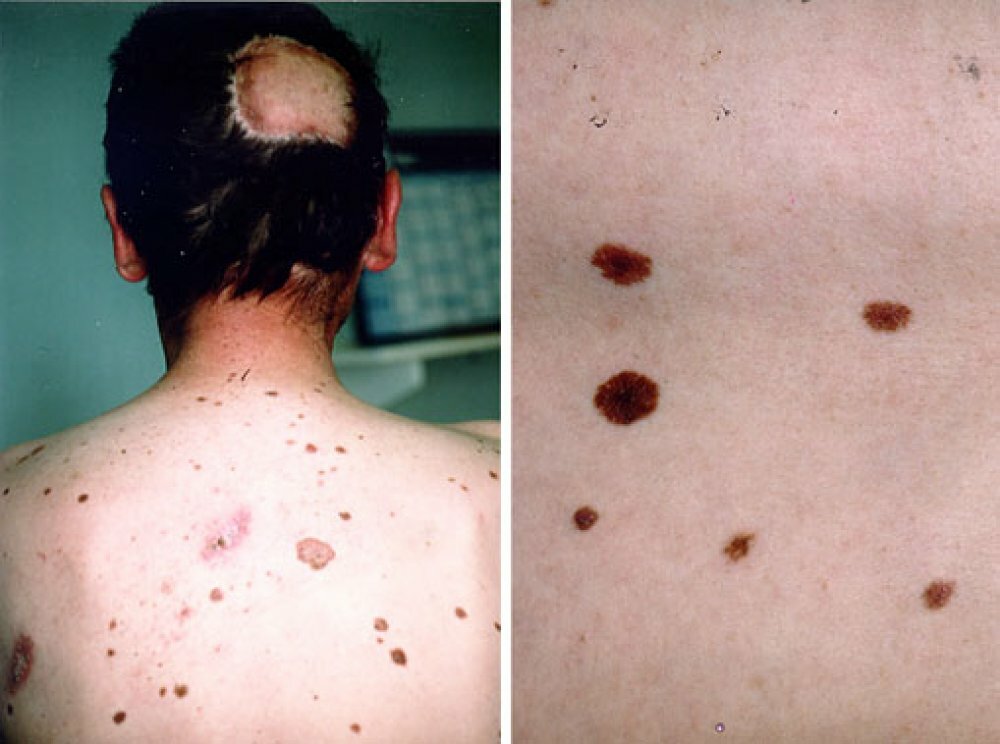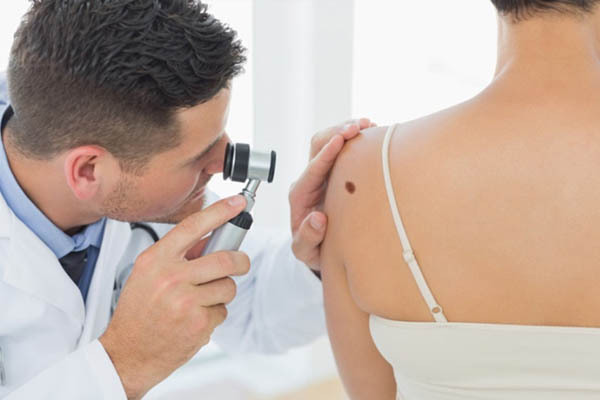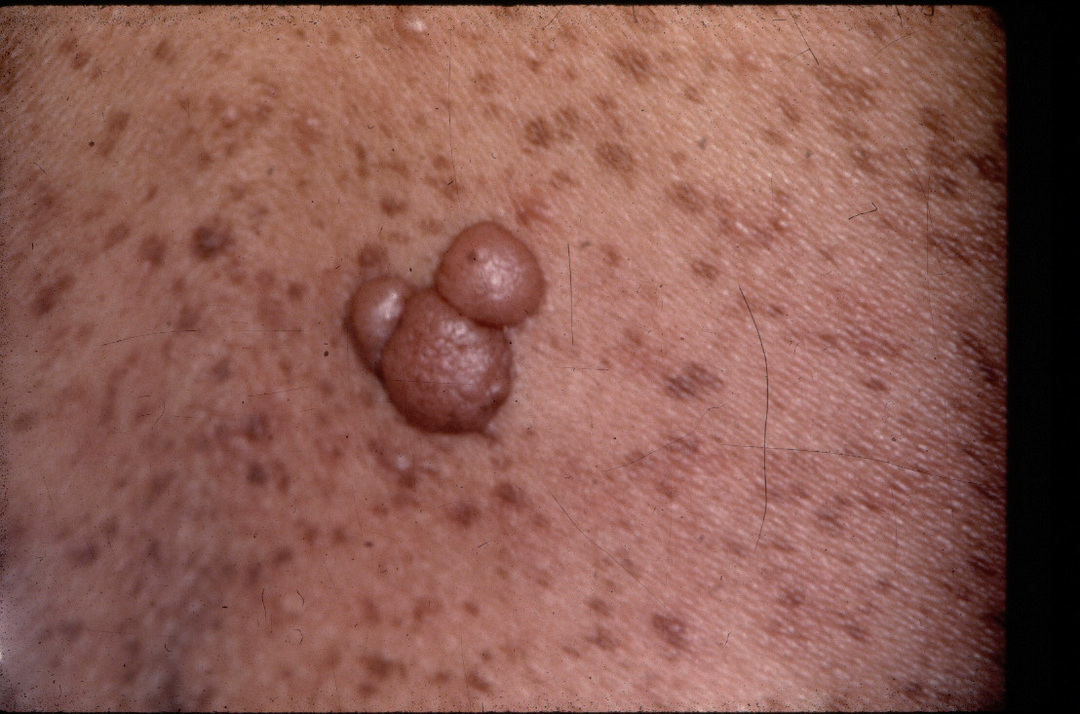Hair loss in men at a young age: causes and treatment

Bruce Willis, Vin Diesel regularly occupy a leading position in the world's most attractive men's lists.Many women believe that it is the hairstyle, or rather its complete absence, that attracts these celebrities.Despite all these arguments, many men, noticing the increased loss of their head of hair or the first signs of baldness, begin to panic.There is a reasonable question: what can be caused by this problem and most importantly how to deal with it?
Table of contents: Causes of hair loss in men Androgenetic alopecia Diffuse hair loss Focal baldness Cicatrical baldness Treatment of alopeciaCauses of hair loss in men
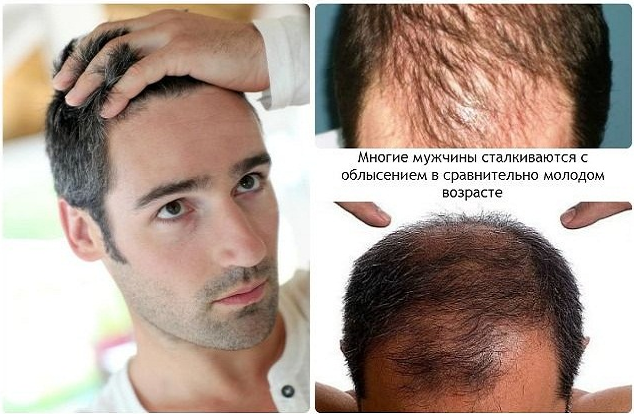
Hair loss can provoke different factors. There are several types of alopecia:
- Androgenetic( androgenic) alopecia;
- focal alopecia;
- diffuse( symptomatic) baldness;
- cicatricial alopecia.
Determine the cause and type of baldness under the strength of a doctor trichologist or dermatologist.Nevertheless, each of these types of baldness has its own characteristics, the presence of which will allow the patient himself to suspect that this or that type of baldness.
Recommended to read:Androgenetic alopecia in men
In most cases this type of alopecia is found in men.In the development of androgenetic alopecia an important role is played by hereditary predisposition.Therefore, if a man is already at a young age began to drop hair actively, it is worth to look closely at close relatives.If the father and grandfather have bald spots on his head, most likely, it is a question of androgenetic baldness, which threatens their descendants.
Androgenetic alopecia is associated with the specific effect of testosterone on the hair follicles.Under the influence of the enzyme 5-alpha-reductase, the hormone is converted into dihydrotestosterone.If the enzyme is excessively active, there is an accumulation of dihydrotestosterone in excess.The latter leads to dystrophy of the hair follicles.As a result, the growing hair becomes thinner, shorter, somewhat discolored, resembling pushrod hair covering the body.
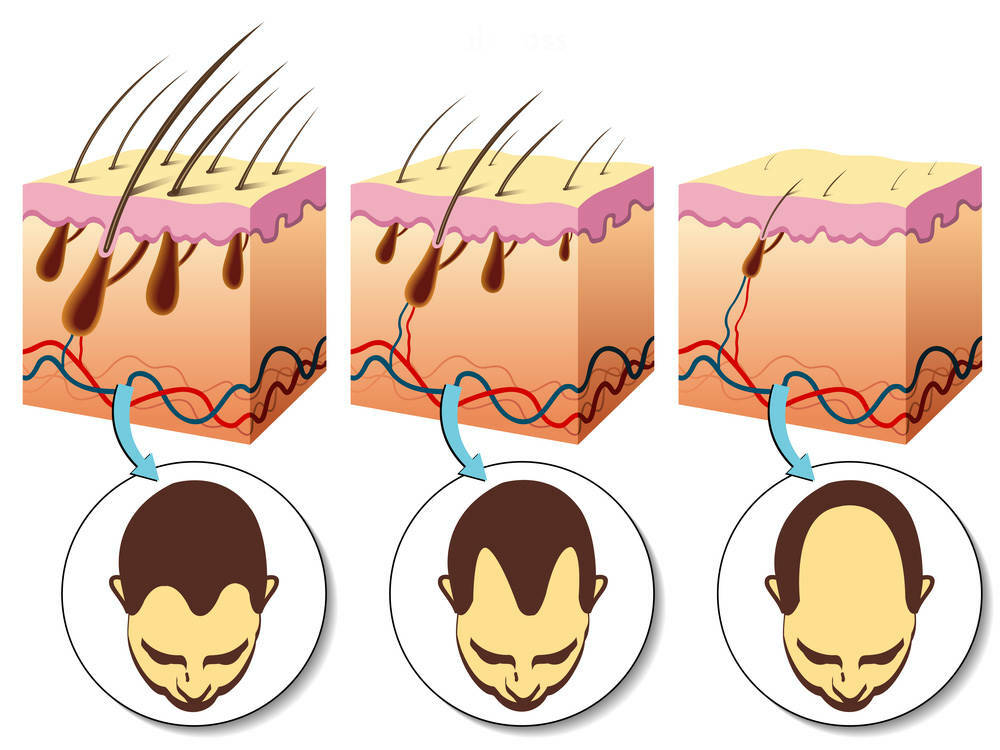
Another mechanism of the disease development is possible, when the enzyme activity is moderate and dihydrotestosterone is produced in a normal amount, but the hair follicles themselves are hypersensitive to the action of the hormone.
Hair follicles of the temporal and parietal regions suffer from this type of alopecia, and the follicles of the occipital region remain resistant to the action of the hormone.So, gradually begins to rise the marginal zone of hair growth, the forehead becomes higher, the temporal bald areas deepen.At the final stages of the disease, a male has a bald head with preserved hair at the back of the head.
Diffuse hair loss
Each hair passes its life cycle, beginning with the anagen( growth phase), going to catagen and ending with telogen( rest phase), after which hair loss and rejection occurs.Soon the hair follicle goes back to the anagen phase, the new hair shaft grows.
However, under the influence of all kinds of unfavorable factors, the cyclicity of hair growth is disturbed, because of which the head of hear begins to fall out.
Diffuse alopecia is also called symptomatic because it occurs in a variety of pathological conditions, such as:
- Endocrine diseases( pathology of the thyroid gland, pituitary gland);
- Medication administration( cytostatics, anticoagulants, retinoids, some antibiotics);
- Stress;
- Lack of protein, iron, zinc in the diet( observed in men following diets or vegetarian);
- Chemical poisoning;
- Reaction to chemotherapy.
In diffuse alopecia, hair falls evenly over the entire head, without definite zoning.If the cause of diffuse alopecia can be established and eliminated, the hair loss and its recovery cease and occur within four to nine months.

Focal alopecia
This form of alopecia often affects children and young people.Characterized by the appearance on the scalp of the head of the roundish center of alopecia.The causes of the disease are still not clear, scientists are increasingly inclined to the autoimmune theory of the origin of the disease.
We recommend reading:The formation of the centers of alopecia is caused by the interruption of the growth cycle of the hair shaft, that is, the hair prematurely enters the telogen phase( rest) and falls out.If the violation of the development cycle occurred in the phase of anagen( growth), then the hair shaft at the root breaks off.
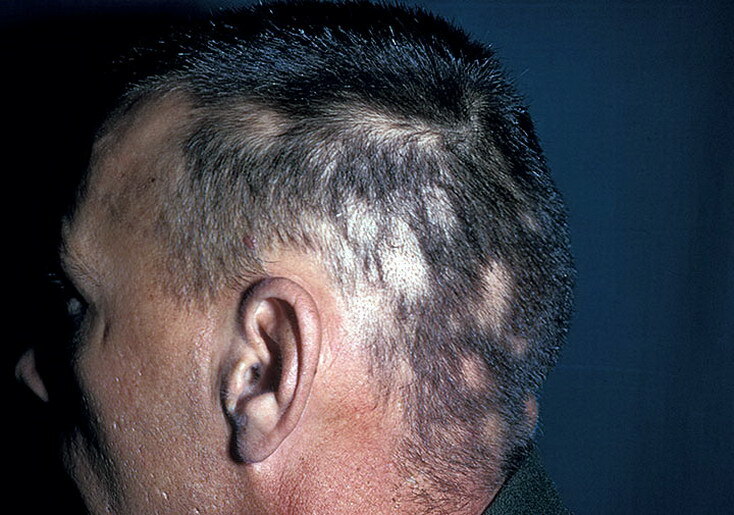 There are various forms of focal alopecia.So, when the form is delimited, only one or several foci of alopecia appear on the head, with a subtotal form on the head there is no more than 40% of the hair, and with the total - all the hair on the head falls out, besides, eyelashes, eyebrows, beards may fall out, and alsoHair on the body.
There are various forms of focal alopecia.So, when the form is delimited, only one or several foci of alopecia appear on the head, with a subtotal form on the head there is no more than 40% of the hair, and with the total - all the hair on the head falls out, besides, eyelashes, eyebrows, beards may fall out, and alsoHair on the body.
It is difficult to predict the course of the disease.Very often the site of alopecia arises suddenly and in itself even without the use of active treatment overgrows with new hair for several months.In other cases, the disease becomes chronic, the existing foci are overgrown, but new foci also appear.
In addition, often patients with focal alopecia affect their nails with the formation of thimble-like impressions, longitudinal furrows.Therefore, changes in the nail plates in humans, together with alopecia, indicate focal alopecia.
Scarring baldness
This type of baldness is rare.Often, cicatrical alopecia develops on the background of head skin trauma, burns.However, often the cause of the disease are infectious diseases of the scalp, as a result of which around the hair follicles are formed areas of inflammation, soon transformed into scar tissue.So, after a furuncle, a deep folliculitis, an abscess on the scalp, there are scars, and sometimes sites of atrophy.
In addition, skin tumors, dermatoses( red lichen, lupus erythematosus, scleroderma) can also become the causes of cicatrical alopecia development.In these areas there is an irreversible damage to the hair follicles.
 The group of cicatricial alopecia is also referred to as Broca's pseudocolel.This is a fairly rare disease, which often occurs in middle age.The first foci of hair loss appear in the parietal and frontal parts of the head.These foci of irregular shape, located asymmetrically, tend to merge.In the areas of alopecia, atrophy of all layers of the skin is observed.The skin itself is whitish-yellow, shiny, thinned, the mouth of the hair follicles is absent.When squeezing, the skin is collected between the fingers in small wrinkles.Within the foci, individual preserved tufts of hair can be observed.
The group of cicatricial alopecia is also referred to as Broca's pseudocolel.This is a fairly rare disease, which often occurs in middle age.The first foci of hair loss appear in the parietal and frontal parts of the head.These foci of irregular shape, located asymmetrically, tend to merge.In the areas of alopecia, atrophy of all layers of the skin is observed.The skin itself is whitish-yellow, shiny, thinned, the mouth of the hair follicles is absent.When squeezing, the skin is collected between the fingers in small wrinkles.Within the foci, individual preserved tufts of hair can be observed.
Treatment of alopecia
Recommended to read:Treatment is conducted taking into account the cause of hair loss and the established form of alopecia.Elimination of the cause( treatment of endocrine diseases, normalization of nutrition, etc.), as a consequence, leads to a cessation of hair loss.
There is only one way to effectively combat androgenetic alopecia: to influence the mechanism of disease development, that is, block the conversion of testosterone to dihydrotestosterone. This can be done with such preparations as:
- Minoxidil( Regeyn);
- Finasteride( Propecia).
Minoxidil is available as a 2% and 5% solution.The product should be rubbed into the affected areas of the head twice a day.It is necessary to conduct such treatment on a regular basis.Soon, hair loss ceases, and new hair grows in thin out areas.
Finasteride blocks the enzyme 5-alpha-reductase.The drug is available in the form of tablets.Doctors recommend using one tablet a day.
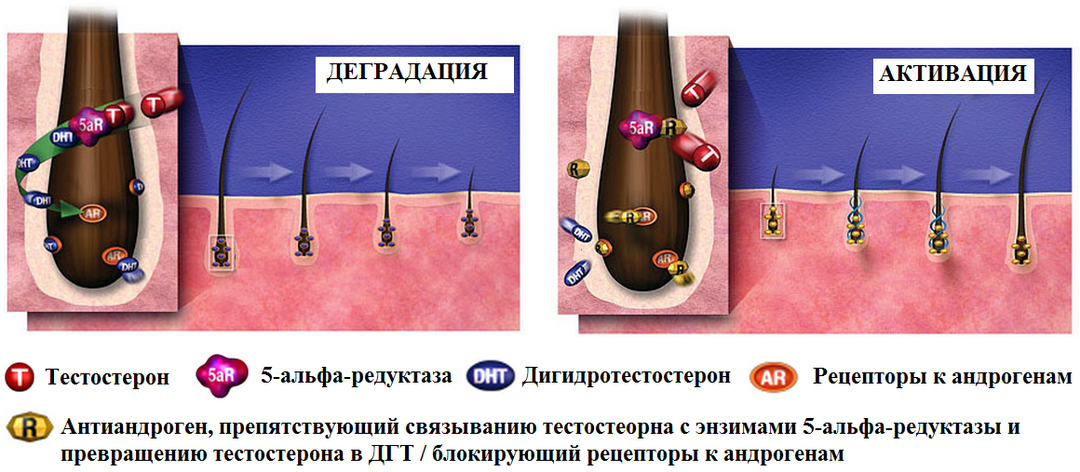
The peculiarity of these medications is that the effect of their administration lasts exactly as much as a man applies them.Unfortunately, after the cessation of treatment, the hair again begins to fall out.Therefore, treatment of androgenetic alopecia is carried out for a long time.
For focal alopecia, the following drugs are used:
- Glucocorticosteroid ointments( betamethasone) - ointment should be rubbed into bald skin areas twice a day for at least two months.
- With a severe and rapidly progressive form of the disease, glucocorticosteroids are administered internally( prednisolone) with a gradual decrease in dosage.
- Minoxidil - apply to affected areas of the skin twice a day.
- Preparations containing zinc( zinc sulfate, zinc oxide) - used inside for three months;
- Pentoxifylin inside within a month;
- Nicotinic acid in the form of tablets or intramuscular injections for ten to twenty days.
In addition, a procedure called PCT, which is an effect on the affected areas of the skin with ultraviolet waves in conjunction with internal or external application of psoralen photosensitizers( isopimninellin, xanthotoxin) may be performed.The procedure is carried out every other day, the entire course is 15-20 procedures.
In cicatricial alopecia hair follicles are atrophied and no medication can restore them.In this case, there is the only effective method of treatment - surgical.Hair transplantation is performed under local anesthesia.A patch of tissue is taken from the area of the skin with the preserved follicles.Grafts are cut from the graft, which then are introduced into the bald areas of the skin.This method is also called the STRIP method.
Increasingly, they resort to the seamless FUE method, when the skin flaps are removed not with a scalpel, but with a special low-injury tool - micropan.
Hair transplantation is also performed with androgenetic alopecia.In this case, hair follicles from the occipital region are allocated and transplanted into the areas of alopecia.
Grigorova Valeria, medical reviewer

